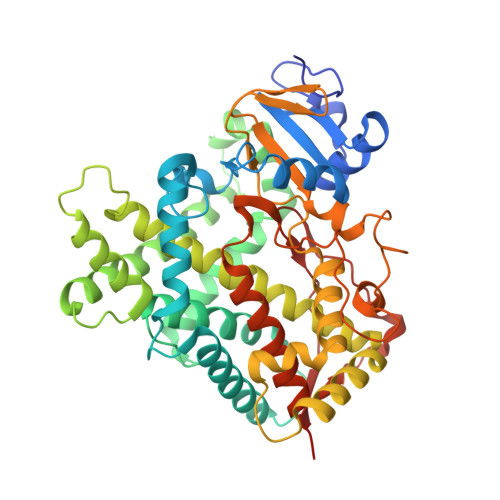Investigation by site-directed mutagenesis of the role of cytochrome P450 2B4 non-active-site residues in protein-ligand interactions based on crystal structures of the ligand-bound enzyme.
Wilderman, P.R., Gay, S.C., Jang, H.H., Zhang, Q., Stout, C.D., Halpert, J.R.(2012) FEBS J 279: 1607-1620
- PubMed: 22051155
- DOI: https://doi.org/10.1111/j.1742-4658.2011.08411.x
- Primary Citation of Related Structures:
3TK3 - PubMed Abstract:
Residues located outside the active site of cytochromes P450 2B have exhibited importance in ligand binding, structural stability and drug metabolism. However, contributions of non-active-site residues to the plasticity of these enzymes are not known. Thus, a systematic investigation was undertaken of unique residue-residue interactions found in crystal structures of P450 2B4 in complex with 4-(4-chlorophenyl)imidazole (4-CPI), a closed conformation, or in complex with bifonazole, an expanded conformation. Nineteen mutants distributed over 11 sites were constructed, expressed in Escherichia coli and purified. Most mutants showed significantly decreased expression, especially in the case of interactions found in the 4-CPI structure. Six mutants (H172A, H172F, H172Q, L437A, E474D and E474Q) were chosen for detailed functional analysis. Among these, the K(s) of H172F for bifonazole was ∼ 20 times higher than for wild-type 2B4, and the K(s) of L437A for 4-CPI was ∼ 50 times higher than for wild-type, leading to significantly altered inhibitor selectivity. Enzyme function was tested with the substrates 7-ethoxy-4-(trifluoromethyl)coumarin, 7-methoxy-4-(trifluoromethyl)coumarin and 7-benzyloxyresorufin (7-BR). H172F was inactive with all three substrates, and L437A did not turn over 7-BR. Furthermore, H172A, H172Q, E474D and E474Q showed large changes in k(cat)/K(M) for each of the three substrates, in some cases up to 50-fold. Concurrent molecular dynamics simulations yielded distances between some of the residues in these putative interaction pairs that are not consistent with contact. The results indicate that small changes in the protein scaffold lead to large differences in solution behavior and enzyme function.
Organizational Affiliation:
Skaggs School of Pharmacy and Pharmaceutical Sciences, University of California San Diego, La Jolla, CA 92093, USA. pwilderman@ucsd.edu
















